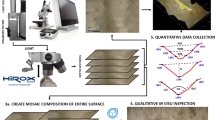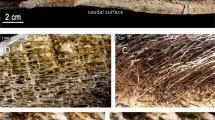Abstract
Taphonomic modifications on animal bones have the potential to provide a wealth of information on the depositional histories of faunal assemblages. However, certain modifications have received little attention and their interpretation remains complex due to their varied or uncertain aetiology. This has hindered progress in approaches to taphonomic research and it remains relatively rare that a comprehensive suite of modifications is recorded during zooarchaeological analysis. Abrasion, defined as a shine or polish on bone, is one such modification, with a plethora of processes having been cited as a potential cause. Relatively little holistic analysis of archaeological specimens has been carried out and consequently the interpretative potential of the modification is yet to be realised. This paper examines the degree to which the process of trampling causes bone abrasion. Trampling causes multiple, sub-parallel, linear striations on bones and has been suggested by some researchers as a cause of abrasion (see Andrews and Cook, Man 20:675–691, 1985; Behrensmeyer et al., Palaeogeogr Palaeocol 63:183–199, 1986; Fiorillo, Univ Wyoming Contrib Geol 26:57–97, 1989; Myers et al., Am Antiquity 45:483–490, 1980; Nielsen, Am Antiquity 56:483–503, 1991; Olsen and Shipman, J Archaeol Sci 15:535–553, 1988). Research presented here involves statistical analysis of a large and diverse faunal dataset from seven British sites. Results from both correlation and logistic regression analysis demonstrate the very close relationship between the two modifications, although this is not the case at every site. These findings strongly suggest that trampling is a major cause of abrasion in a British context. Once the relationship is established at a specific site, the modification can be more reliably used for reconstructing the taphonomic trajectory of an assemblage.



Similar content being viewed by others
References
Andrews P (1990) Owls, caves and fossils. University of Chicago Press, Chicago
Andrews P (1995) Experiments in taphonomy. J Archaeol Sci 22:147–153
Andrews P, Cook J (1985) Natural modifications to bone in a temperate setting. Man 20:675–691
Andrews P, Fernández-Jalvo Y (1997) Surface modifications of the Sima los Huesos fossil humans. J Hum Evol 33:191–217
Argast S, Farlow JD, Gabet RM, Brinkman DL (1987) Transport-induced abrasion of fossil reptilian teeth: implications for the existence of tertiary dinosaurs in the Hell Creek Formation, Montana. Geology 15:927–930
Armour-Chelu M, Andrews P (1994) Some effects of bioturbation by earthworms (Oligochaeta) on archaeological sites. J Archaeol Sci 21:433–443
Bartosiewicz L (2008) Taphonomy and palaeopathology in archaeozoology. Geobios 41:69–77
Behrensmeyer AK (1982) Time resolution in fluvial vertebrate assemblages. Paleobiology 8:211–227
Behrensmeyer AK (1988) Vertebrate preservation in fluvial channels. Palaeogeogr Palaeoclimatol 63:183–199
Behrensmeyer AK (1990) Bones. In: Briggs DEG, Crowther PR (eds) Palaeobiology: a synthesis. Blackwell Scientific, Oxford, pp 232–235
Behrensmeyer AK, Gordon KD, Yanagi GT (1986) Trampling as a cause of bone surface damage and pseudo-cutmarks. Nature 319:768–771
Behrensmeyer AK, Gordon KD, Yanagi GT (1989) Nonhuman bone modification in Miocene fossils from Pakistan. In: Bonnischen R, Sorg MH (eds) Bone modification. Centre for the Study of the First Americans, Institute for Quaternary Studies. University of Maine, Orono, ME, pp 99–120
Blasco R, Rosell J, Fernández Peris J, Cáceres I, María Vergeìs J (2008) A new element of trampling: an experimental application on the Level XII faunal record of Bolomor Cave (Valencia, Spain). J Archaeol Sci 35:1605–1618
Brain CK (1981) The hunters or the hunted? An introduction to African cave taphonomy. University of Chicago Press, Chicago
Bromage TG (1984) Interpretation of scanning electron microscopic images of abraded forming bone surfaces. Am J Phys Anthropol 64:161–178
Buc N (2011) Experimental series and use-wear in bone tools. J Archaeol Sci 38:546–557
Bunn HT (1981) Archaeological evidence for meat-eating by Plio–Pleistocene hominids from Koobi Fora and Olduvai Gorge. Nature 291:574–577
Clarke D (1977) Spatial archaeology. Academic Press, New York
Courtin J, Villa P (1982) Une expérience de piétinement. Bulletin, Société Préhistorique Française 79:117–123
Coy JP (1975) Iron Age cookery. In: Classon AT (ed) Archaeozoological studies. North Holland and American Elsevier, Amsterdam, pp 426–430
Davies DJ, Powell EN, Stanton RJ (1989) Taphonomic signature as a function of environmental process - shells and shell beds in a hurricane-influenced inlet on the Texas coast. Palaeogeogr Palaeoclimatol 72:317–356
Denys C (2002) Taphonomy and experimentation. Archaeometry 44:469–484
Domínguez-Rodrigo M, de Juana S, Galán AB, Rodríguez M (2009) A new protocol to differentiate trampling marks from butchery cut marks. J Archaeol Sci 36:2643–2654
Domínguez-Solera SD, Domínguez-Rodrigo M (2009) A taphonomic study of bone modification and of tooth-mark patterns on long limb bone portions by suids. Int J Osteoarchaeol 19:345–363
Efron B (1982) The jackknife, the bootstrap, and other resampling plans. CBMS-NSF Monograph no. 38. Society of Industrial and Applied Mathematics, Bristol
Fernández-Jalvo Y (1992) Tafonomia de Microvertebrados del complejo carstico de Atapuerca (Burgos). PhD thesis, Universidad Complutense de Madrid
Fernández-Jalvo Y, Andrews P (2003) Experimental effects of water abrasion on bone fragments. J Taphonomy 1:145–161
Fiorillo AR (1984) An introduction to the identification of trample marks. Curr Res 1:47–48
Fiorillo AR (1988) Taphonomy of hazard homestead quarry (Ongalla Group), Hitchcock County, Nebraska. Univ Wyoming Contrib Geol 26:57–97
Fiorillo AR (1989) Bone modification. Centre for the Study of the First Americans, Institute for Quaternary Studies. In: Bonnischen R, Sorg MH (eds) Bone modification. Centre for the Study of the First Americans, Institute for Quaternary Studie. University of Maine, Orono, ME, pp 61–72
Fisher JW (1995) Bone surface modifications in zooarchaeology. J Archaeol Method Theory 2:7–68
Green FJ (1994) Early Iron Age stream deposits at La Sagesse, Romsey, Hampshire. In: Fitzpatrick AP, Morris EL (eds) The Iron Age in Wessex: recent work. The Trust for Wessex Archaeology, Salisbury, pp 49–52
Haynes G (1980) Evidence of carnivore gnawing on Pleistocene and recent mammalian bones. Paleobiology 6:341–351
Haynes G, Stanford D (1984) On the possible utilisation of Camelops by early man in North America. Quat Res 22:216–230
Hutson JM, Burke CC, Haynes G (2013) Osteophagia and bone modifications by giraffe and other large ungulates. J Archaeol Sci 40:4139–4149
Krajcarz M, Krajcarz MT (2013) The red fox (Vulpes vulpes) as an accumulator of bones in cave-like environments. Int J Osteoarchaeol. doi:10.1002/oa.2233
Lloveras L, Moreno-García M, Nadal J (2012) Feeding the foxes: an experimental study to assess their taphonomic signature on leporid remains. Int J Osteoarchaeol 22:577–590
Lyman RL (1994) Vertebrate taphonomy. Cambridge University Press, Cambridge
Macphail R (2000) Soils and microstratigraphy: a soil micromorphological and microchemical approach. In: Lawson AJ (ed) Potterne 1982–5: Animal husbandry in later prehistoric Wiltshire. The Trust for Wessex Archaeology, Salisbury, pp 47–70
Madgwick R (2008) Patterns in the modification of human and animal bones in Iron Age Wessex: Revisiting the excarnation debate. In: Davis O, Sharples N, Waddington K (eds) Changing perspectives on the first millennium BC. Oxbow, Oxford, pp 99–118
Madgwick R (2010) Bone modification and the conceptual relationship between humans and animals in Iron Age Wessex. In: Morris J, Maltby M (eds) Integrating social and environmental archaeologies: reconsidering deposition. BAR International Series 2077. Archaeopress, Oxford, pp 66–82
Madgwick R (2011) Investigating the potential of holistic taphonomic analysis in zooarchaeological research. PhD thesis, Cardiff University
Madgwick R, Mulville J (2012) Investigating variation in the prevalence of weathering in faunal assemblages in the United Kingdom: a multivariate statistical approach. Int J Osteoarchaeol 22:509–522
Martill DM (1990) Bones as stones: the contribution of vertebrate remains to the lithologic record. In: Donovan SK (ed) The processes of fossilisation. Columbia University Press, New York, pp 270–292
McOmish D, Field D, Brown G (2010) The Late Bronze Age and Early Iron Age midden site at East Chisenbury, Wiltshire. Wiltshire Archaeol Nat Hist Mag 103:35–101
Meldahl KH, Flessa KW (1990) Taphonomic pathways and comparative biofacies and taphofacies in a recent intertidal shallow shelf environment. Lethaia 23:43–60
Morris JA, Gardner MJ (1988) Calculating confidence intervals for relative risks (odds ratios) and standardised ratios and rates. Brit Med J 296:1313–1316
Nicholson RA (1992) Bone survival: The effects of sedimentary abrasion and trampling on fresh and cooked bone. Int J Osteoarchaeol 2:79–90
Nielsen AE (1991) Trampling the archaeological record: an experimental study. Am Antiq 56:483–503
O'Connor TP (2008) The archaeology of animal bones. Sutton, Stroud
Oliver JS (1989) Analogues and site context: Bone damages from Shield Trap Cave (24CB91), Carbon County, Montana, USA. In: Bonnischen R, Sorg MH (eds) Bone modification. Centre for the Study of the First Americans, Institute for Quaternary Studies. University of Maine, Orono, ME, pp 73–99
Olsen SL, Shipman P (1988) Surface modification on bone: trampling versus butchery. J Archaeol Sci 15:535–553
Orton DC (2012) Taphonomy and interpretation: an analytical framework for social zooarchaeology. Int J Osteoarchaeol 22:320–337
Parsons KM, Brett CE (1991) Taphonomic processes and biases in modern marine environments, an actualistic perspective on fossil assemblage preservation. In: Donovan SK (ed) The processes of fossilization. Columbia University Press, New York, pp 22–65
Pinto Llona AC, Andrews PJ (1999) Amphibian taphonomy and its application to the fossil record of Dolina (middle Pleistocene, Atapuerca, Spain). Palaeogeogr Palaeoclimatol 149:411–429
Potts R, Shipman P (1981) Cut-marks made by stone tools on bones from Olduvai Gorge, Tanzania. Nature 291:577–580
Redfern R (2008) New evidence for Iron Age secondary burial practice and bone modification from Gussage All Saints and Maiden Castle (Dorset, England). Oxford J Archaeol 27:281–301
Rice WR (1989) Analyzing tables of statistical tests. Evolution 43:223–225
Robinson S, Nicholson RA, Pollard AM, O'Connor TP (2003) An evaluation of nitrogen porosimetry as a technique for predicting taphonomic durability in animal bone. J Archaeol Sci 30:391–403
Russell A (2010) Structured deposition or casual disposal of human remains? A case study of four Iron Age sites from southern England. In: Morris J, Maltby M (eds) Integrating social and environmental archaeologies: reconsidering deposition. BAR International Series 2077. Archaeopress, Oxford, pp 45–65
Symmons R (2005) Taphonomy and Çatalhöyük: How animal bone taphonomy can enhance our interpretative powers. In: Buitenhuis H, Choyke AM, Martin L, Bartosiewicz L, Mashkour M (eds) Archaeozoology of the Near East VI. ARC-Publicaties, Groningen, pp 103–111
Thompson JC (2005) The impact of post-depositional processes on bone surface modification frequencies: a corrective strategy and its application to the Loigongalani Site, Serengeti Plain, Tanzania. J Taphonomy 3:67–89
Thompson CEL, Ball S, Thompson TJU, Gowland R (2011) The abrasion of modern and archaeological bones by mobile sediments: the importance of transport modes. J Archaeol Sci 38:784–793
Waddington K, Sharples NM (2011) The Whitchurch excavations 2006–2009: an interim report. School of History and Archaeology, Cardiff
Waterman DM (1997) Excavations at Navan Fort 1961–71. Department of the Environment for Northern Ireland, Belfast
Acknowledgments
This study would not have been possible without the assistance of numerous museum staff that assisted with access to material, including Kay Ainsworth, David Allen, David Dawson, Jodie Deacon, Malcolm Fry, Adam Gwilt, Finbar McCormick, Lisa Webb and Peter Woodward. Data for this research was collected during an AHRC-funded PhD and I owe a debt of a gratitude to Jacqui Mulville who supervised the research. I am also very grateful to Jonathan Gillard for advice on statistical analysis, Clare Randall for guidance on Eldon's Seat matrix character and to Matt Law and two anonymous reviewers whose comments brought about considerable improvements to this paper.
Author information
Authors and Affiliations
Corresponding author
Rights and permissions
About this article
Cite this article
Madgwick, R. What makes bones shiny? Investigating trampling as a cause of bone abrasion. Archaeol Anthropol Sci 6, 163–173 (2014). https://doi.org/10.1007/s12520-013-0165-0
Received:
Accepted:
Published:
Issue Date:
DOI: https://doi.org/10.1007/s12520-013-0165-0




